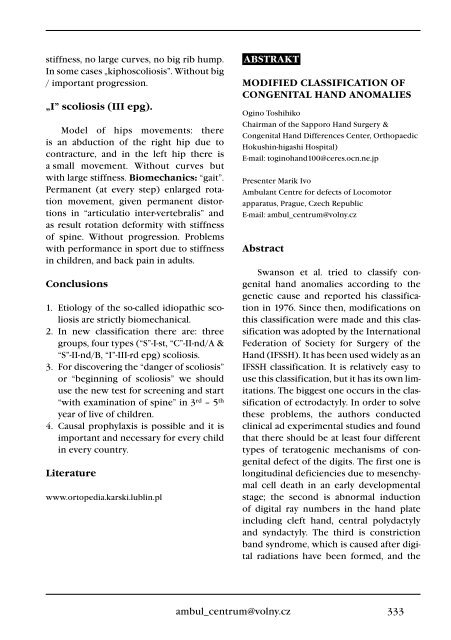3+4+Supplementum/2012 - Společnost pro pojivové tkáně
3+4+Supplementum/2012 - Společnost pro pojivové tkáně
3+4+Supplementum/2012 - Společnost pro pojivové tkáně
- TAGS
- www.pojivo.cz
You also want an ePaper? Increase the reach of your titles
YUMPU automatically turns print PDFs into web optimized ePapers that Google loves.
stiffness, no large curves, no big rib hump.<br />
In some cases „kiphoscoliosis”. Without big<br />
/ important <strong>pro</strong>gression.<br />
„i” scoliosis (iii epg).<br />
Model of hips movements: there<br />
is an abduction of the right hip due to<br />
contracture, and in the left hip there is<br />
a small movement. Without curves but<br />
with large stiffness. Biomechanics: “gait”.<br />
Permanent (at every step) enlarged rotation<br />
movement, given permanent distortions<br />
in “articulatio inter-vertebralis” and<br />
as result rotation deformity with stiffness<br />
of spine. Without <strong>pro</strong>gression. Problems<br />
with performance in sport due to stiffness<br />
in children, and back pain in adults.<br />
Conclusions<br />
1. Etiology of the so-called idiopathic scoliosis<br />
are strictly biomechanical.<br />
2. In new classification there are: three<br />
groups, four types (“S”-I-st, “C”-II-nd/A &<br />
“S”-II-nd/B, “I”-III-rd epg) scoliosis.<br />
3. For discovering the “danger of scoliosis”<br />
or “beginning of scoliosis” we should<br />
use the new test for screening and start<br />
“with examination of spine” in 3 rd – 5 th<br />
year of live of children.<br />
4. Causal <strong>pro</strong>phylaxis is possible and it is<br />
important and necessary for every child<br />
in every country.<br />
literature<br />
www.ortopedia.karski.lublin.pl<br />
aBSTRakT<br />
ambul_centrum@volny.cz<br />
MOdified ClaSSifiCaTiOn Of<br />
COnGeniTal Hand anOMalieS<br />
Ogino Toshihiko<br />
Chairman of the Sapporo Hand Surgery &<br />
Congenital Hand Differences Center, Orthopaedic<br />
Hokushin-higashi Hospital)<br />
E-mail: toginohand100@ceres.ocn.ne.jp<br />
Presenter Marik Ivo<br />
Ambulant Centre for defects of Locomotor<br />
apparatus, Prague, Czech Republic<br />
E-mail: ambul_centrum@volny.cz<br />
abstract<br />
Swanson et al. tried to classify congenital<br />
hand anomalies according to the<br />
genetic cause and reported his classification<br />
in 1976. Since then, modifications on<br />
this classification were made and this classification<br />
was adopted by the International<br />
Federation of Society for Surgery of the<br />
Hand (IFSSH). It has been used widely as an<br />
IFSSH classification. It is relatively easy to<br />
use this classification, but it has its own limitations.<br />
The biggest one occurs in the classification<br />
of ectrodactyly. In order to solve<br />
these <strong>pro</strong>blems, the authors conducted<br />
clinical ad experimental studies and found<br />
that there should be at least four different<br />
types of teratogenic mechanisms of congenital<br />
defect of the digits. The first one is<br />
longitudinal deficiencies due to mesenchymal<br />
cell death in an early developmental<br />
stage; the second is abnormal induction<br />
of digital ray numbers in the hand plate<br />
including cleft hand, central polydactyly<br />
and syndactyly. The third is constriction<br />
band syndrome, which is caused after digital<br />
radiations have been formed, and the<br />
333

















